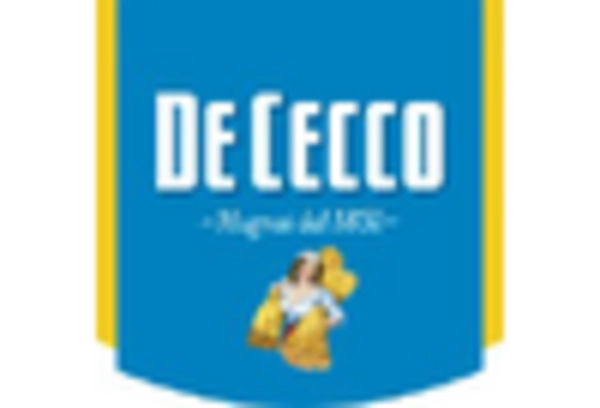Increased Focus on Convenience
Convenience remains a driving force in the pasta market in Germany, as busy lifestyles prompt consumers to seek quick and easy meal solutions. The demand for ready-to-cook and pre-packaged pasta products is on the rise, with market data suggesting that convenience-oriented products have increased sales by approximately 20% in the last year. The pasta market is responding by enhancing packaging and product formats to meet consumer needs for speed and simplicity. This trend is particularly evident in urban areas, where time constraints influence purchasing decisions. As convenience continues to be a priority for consumers, manufacturers are likely to invest in developing products that offer both quality and ease of preparation, thereby reinforcing their market position.
Innovative Product Development
Innovation plays a crucial role in the pasta market in Germany, as manufacturers strive to differentiate their products in a competitive landscape. The introduction of new flavors, shapes, and formulations is becoming increasingly common, with companies experimenting with alternative ingredients such as legumes and whole grains. This trend is supported by Market Research Future indicating that pasta made from alternative grains has seen a growth rate of around 10% in recent years. The pasta market is responding to evolving consumer preferences by launching innovative products that cater to diverse dietary needs, including gluten-free and high-protein options. Such developments not only attract a broader customer base but also enhance the overall market appeal, positioning the industry for sustained growth.
Rising Demand for Organic Products
The pasta market in Germany is experiencing a notable shift towards organic products. Consumers are increasingly prioritizing health and wellness, leading to a surge in demand for organic pasta options. This trend is reflected in market data, indicating that organic pasta sales have grown by approximately 15% over the past year. The pasta market is adapting to this demand by expanding its offerings of organic varieties, which are perceived as healthier alternatives. As consumers become more aware of the benefits of organic ingredients, manufacturers are likely to invest in sourcing high-quality organic grains and ingredients. This shift not only caters to health-conscious consumers but also aligns with broader trends in sustainable agriculture, further enhancing the appeal of organic pasta in the German market.
Growing Interest in Plant-Based Diets
The pasta market in Germany is witnessing a growing interest in plant-based diets, which is reshaping consumer preferences and purchasing behaviors. As more individuals adopt vegetarian and vegan lifestyles, the demand for plant-based pasta options is increasing. Market data indicates that sales of plant-based pasta have surged by approximately 25% over the past year, reflecting a significant shift in dietary choices. The pasta market is responding by expanding its range of plant-based products, utilizing ingredients such as chickpeas, lentils, and quinoa. This trend not only caters to health-conscious consumers but also aligns with environmental sustainability goals, as plant-based diets are often associated with lower carbon footprints. The industry's ability to adapt to these changing preferences is likely to drive future growth.
E-commerce Growth and Digital Transformation
The pasta market in Germany is experiencing a transformation driven by the growth of e-commerce. As consumers increasingly turn to online shopping for convenience, the demand for pasta products through digital channels is rising. Recent data suggests that online sales of pasta have increased by approximately 30% in the last year, indicating a shift in consumer purchasing habits. The pasta market is adapting to this trend by enhancing its online presence and investing in digital marketing strategies. This shift not only allows manufacturers to reach a broader audience but also provides consumers with greater access to a variety of products. As e-commerce continues to expand, the industry is likely to see further innovations in distribution and marketing, positioning itself for sustained growth in the digital age.

















Leave a Comment